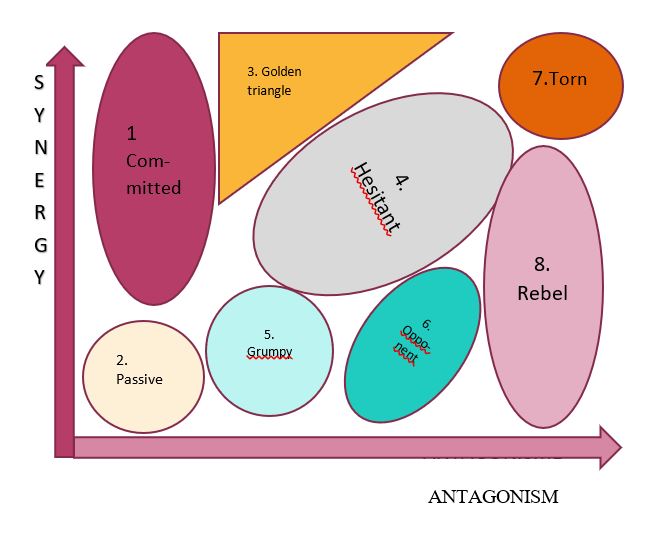Belgian private security sector #5: Actors
This fifth chapter focusses on the private security actors.
Who are they, how to identify them, what are their issues and objectives, which ones converge or diverge, what themes do they prioritize on, what are their power relations, and finally, how can we map them in a lobby perspective?
This series of publications are extracted from my final paper written within the frame of university certificate on foresight (UCL – Sept 2018)

Actors
In order not to miss any of them, we decided to list them in different categories:
Those with the money | Those with the knowledge and the ideas | Those in power | The ones with the address book | Those who oppose... or collaborate! |
|---|---|---|---|---|
Business clients of security services | Industry Experts | Legislator | Professional Associations | Competitors |
Leading security companies | Criminologists | Public authorities | Private Associations | Police |
Political parties | Field Officers | Political parties | Political parties | Army |
Private security companies (guarding, services and security systems providers) | Private security companies | |||
Study centres of Political parties | Citizens | |||
Security guards | ||||
Perpetrators of offences or crimes | ||||
Victims of crime or criminal offences | ||||
Political parties |
Political
As far as the actors are concerned, we put the focus on the political aspect. Indeed, political parties are found in all – or almost all – of the categories we have identified.
We decided to look further into the study centres of political parties. Since the sponsor was particularly interested, we developed a « study centre » fact sheet. It seemed interesting to us to define the attitude, the strategic and ideological position and the possible means of action of the parties.

MACTOR : Interactions Method
We opted for the MACTOR method. « The MACTOR method is a method that models the interactions between the different actors of a project or an organization. It stems from the work of Michel Godet in 1990 and aims to define a Matrix of Alliances, Conflicts, Tactics & Objectives between these different actors, as well as the Recommendations that could result from it»[1].
This method consists of 7 phases
1. Actors Identification
It seems to us to be particularly well adapted to the actors of the political world. We have two avenues of application. Indeed, it could apply:
- within the political actors, that is to say by confronting the parties with each other…
- to political parties taken as a whole and comparing them with the other categories of actors identified above
Actor 1 | Actor 2 | Actor 3 | |
|---|---|---|---|
Actor 1 | aims and objectives actor 1 | Means of influence of actor 1 on actor 2 | Means of influence of actor 1 on actor 3 |
Actor 2 | Means of influence of actor 2 on actor 1 | aims and objectives actor 2 | Means of influence of actor 2 on actor 3 |
Actor 3 | Means of influence of actor 3 on actor 1 | Means of influence of actor 3 on actor 2 | aims and objectives actor 3 |
Figure: MACTOR Method – step 1. Source: www.lescahiersdelinnovation.com
2. Identification of strategic issues and associated objectives
We took the opportunity to make an actor’s card and, to do so, we have :
- contacted the political parties to identify the study centres in question and, above all, the security experts;
- consulted the existing literature on the subject (charter, website, …)
- Identified the issues and objectives
- compared the results obtained through desk research during face-to-face interviews (whenever possible)
For Belgium, the annual turnover was around EUR 663 million, 90% of which was generated by the 5 largest companies in the sector. Note that in the meantime (Q4 2019), two actors joined forces with the acquisition of Fact Group by Protection Unit.
An actor card will be created for the different parties and their respective study centres.
We will limit ourselves to the political parties with representation in the federal parliament:
- CD&V : Christen Democratisch & Vlaams
- cdH : centre démocrate humaniste
- ECOLO : écologistes confédérés pour l’organisation de luttes originales
- DéFI : démocrate fédéraliste indépendant
- Groen
- MR : Mouvement Réformateur
- N-VA : Nieuw-Vlaamse Alliantie
- Open VLD : Open Vlaamse Liberalen en Democraten
- PP: Parti Populaire
- Parti Socialiste
- Ptb: Parti du travail de Belgique
- A : Socialistische Partij Anders
- Vlaams Belang
As the MACTOR method generally applies to a number of actors ranging from 10 to 20, we are here in a good average.
To go further
Fact sheets on non-political actors could, of course, be developed at a later stage.
Interested in receiving an example for a political party? Do not hesitate to contact us! We will be more than happy to freely send it.
3. Identification of convergences and divergences
Then, we will create an actors/objectives matrix [1MAO] to see the points of convergence and divergence.
Scoring system :
+1 = actor favourable to the achievement of the objective
0 = neutral actor in relation to the objective
-1 = actor unfavourable to the achievement of the objective
Example (dated Sept 2018):
ACTORS | DéFI | MR | ... |
|---|---|---|---|
OBJECTIVES | |||
Re-establish the authority of the State for a society of trust | +1 | ||
Refuse the privatisation of security missions/tasks | +1 | ||
Defend the exclusive jurisdiction of the police services for any measure of constraint on persons | +1 | ||
Align the budget allocated to Justice with the European average (1.8% GDP) (currently 0.9% GDP) | +1 | ||
Defend community policing as the most effective way to fight crime | +1 | ||
Propose an ambitious plan to invest in new technologies for police forces | +1 | ||
Propose an ambitious plan to invest in new technologies for police forces | +1 | ||
Level the playing field with organized crime | +1 | ||
Create the Federal Intelligence Agency to deploy officers outside the country | +1 | ||
Strengthen the judiciary and the specialized police force | +1 | ||
Prevent the trivialization of violence against representatives by systematically prosecuting it | +1 | ||
Avoid abuse of the use of force by the police (camera wearing) | +1 |
4. Prioritization of convergences and divergences
We will now establish a matrix of the impact of the actors’ objectives on each other.
E.g.: the objective of actor 1 has a strong impact on actor 2.
Scoring system :
0 = the objective has little impact
+/- 1 = the objective of actor « A1 » has consequences on the operating process of actor « A2 ».
5. Assessment of power relations between actors
We will build a matrix of direct influences between actors according to their means of action.
There are, however, limits to the system insofar as these means of action :
– are not always known because there are sensitive information that parties are not always inclined to share…
– are of variable geometry depending on their position in government or in opposition and therefore, at the time the analysis is carried out: in the pre-electoral period (the case at hand) or at the beginning of the term of office
– « incidentally », it is the citizens who will vote …
+/- 4 = the actor « A1 » can question or reinforce the existence of the actor « A2 ».
+/- 3 = the actor « A1 » can question or reinforce the missions of « A2 ».
+/- 2 = actor « A1 » can question or support the projects of actor « A2 ».
+/- 1 = the actor « A1 » can question or reinforce the operating processes of the actor « A2 ».
0 = actor « A1 » has no influence on actor « A2 ».
6. Integration of power relations at the stage of identifying convergences and divergences
Indeed, if one player weighs more heavily than the others (e.g. twice as much), the ratings assigned at this stage should be impacted accordingly (e.g. doubled).
7. Issuing recommendations
Given these power games, we will be able to make recommendations for the future.
ACTORS' mapping
Finally, as a complement to the MACTOR method, it seems interesting to us, from a lobbying point of view, to map the actors according to their character of favorable or opposed to private security (to the seizing of police tasks, …). They will thus be positioned according to 2 axes: synergy and antagonism.
This exercise could be carried out for all the themes for which decrees have yet to be published. In view of the expected number, it will certainly be necessary to « choose one’s battles ».

To go further
For each category of actors we will look at, we will choose an appropriate method of analysis: MACTOR for political parties PORTER for the analysis of the competitive context (will include private security companies, police, army, ...) …
Sources, Useful links & Resources
[1] Sarr P. (2016). Repéré à https://www.lescahiersdelinnovation.com/2016/02/la-methode-mactor-l-analyse-des-strategies-d-acteurs/
Michel Godet literature
Executive Master en Intelligence Stratégique – HEC-ULg – 2015
Loi du 2 octobre 2017 sur la sécurité privée et particulière
www.ejustice.just.fgov.be/doc/rech_f.htm
Législation codifiée Codex Private Security